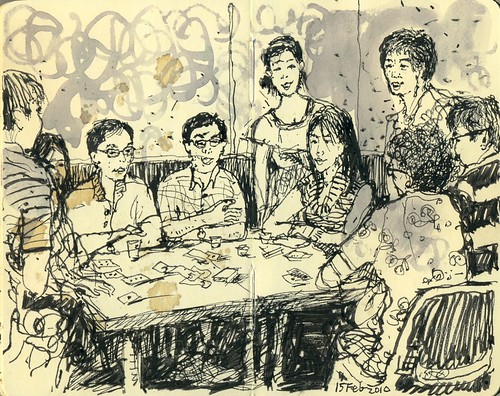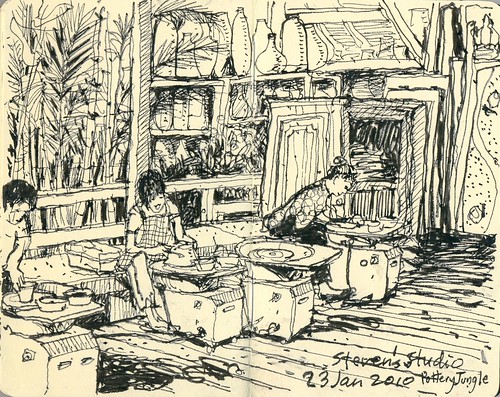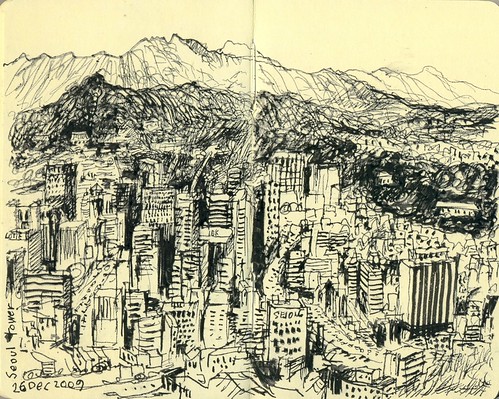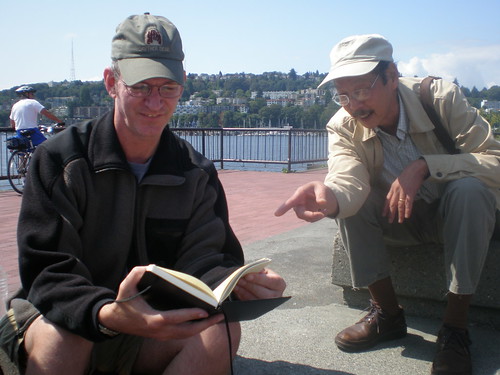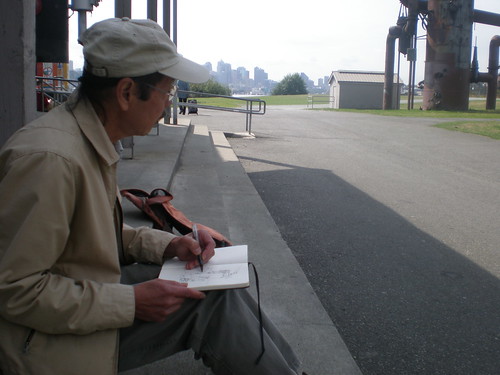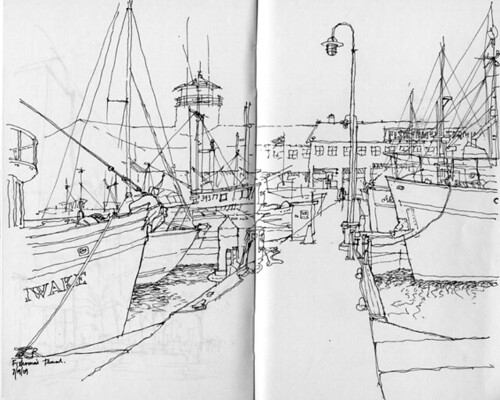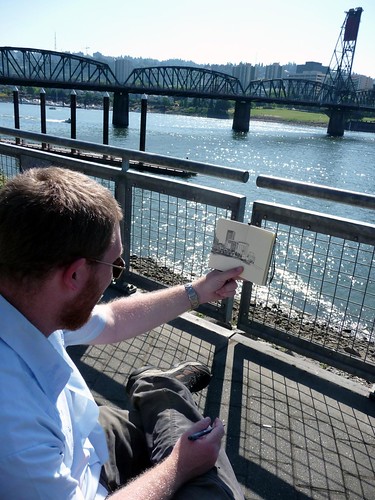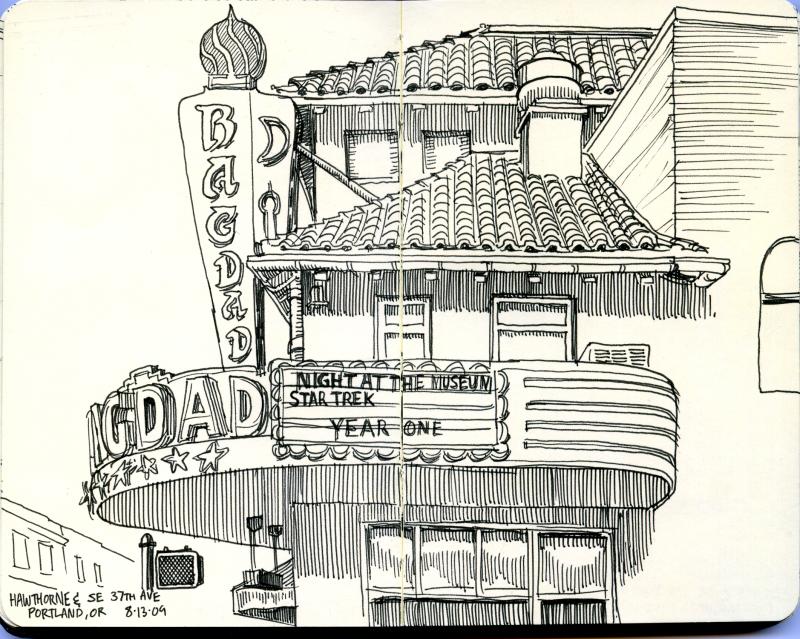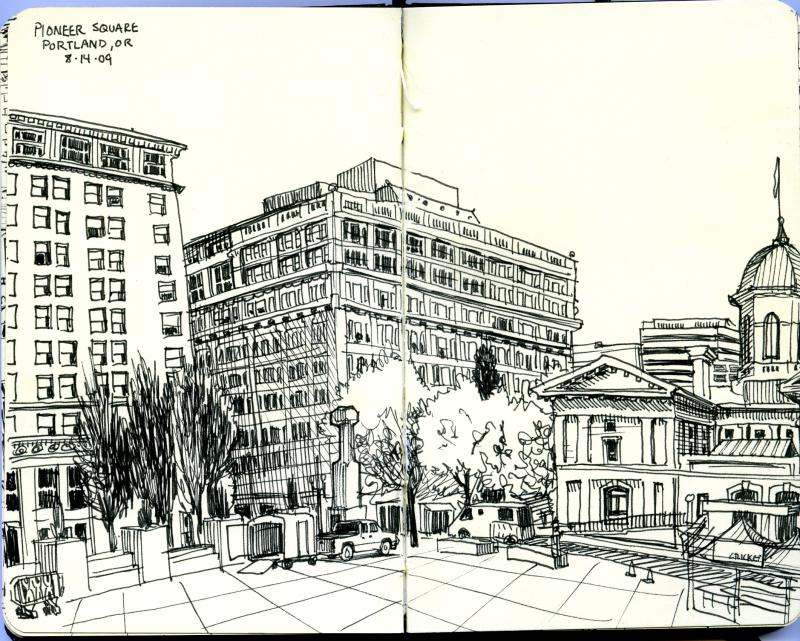Thursday, April 29, 2010
Drawing the line about food
Wow, I can't believe Portland has almost 400 food carts!
With all the sketching around that we'll be doing during the Symposium, some of these may come handy for a quick bite. I look forward to trying some of the many ethnic cuisines represented, as well as sketching the carts.
Food Carts Portland has a wealth of information about all the different types of cuisines represented. I already found one that serves patatas bravas.
Wednesday, April 28, 2010
Tia leads sketchers in Singapore

For the past year, Symposium presenter Tia Boon Sim has led regular sketch outings with other fellow sketchers in her home country of Singapore. They share their drawings on the Urban Sketchers Singapore blog, a unique window into the places, people and culture of the island-city-nation. I always enjoy a visit for a dose of inspiration and look forward to hearing more about Tia's experience sketching in Singapore during the Symposium.
Labels:
TIA
Sunday, April 25, 2010
Interview with presenter Tia Boon Sim
 When I first encountered Tia Boon Sim's drawings during my daily scroll down the Urban Sketchers blog, I stopped and looked for a long time. Her work is so lively, so interesting and so full of texture and life! The word that best describes her drawings is HUMAN.
When I first encountered Tia Boon Sim's drawings during my daily scroll down the Urban Sketchers blog, I stopped and looked for a long time. Her work is so lively, so interesting and so full of texture and life! The word that best describes her drawings is HUMAN.Tia's posts are often full of the joys of her daily life. We see her pottery studio, her many students out sketching, her family playing cards at New Years. Her work gives the sense of someone who lives as an artist through everything she does. As one reads her posts it also becomes clear that Tia passes that passion on to her students.
An architect and educator, Tia is also involved in many other forms of artistic expression, including her gorgeous location drawings. I recently had the chance to ask her a few questions via email and hope you enjoy reading her thoughts below. I look forward to meeting Tia in Portland this summer!
Location drawing, painting, design, architecture, sculpture, pottery: your interests in the arts are diverse. Do you have any thoughts to share regarding how the differing disciplines inform each other? Is there one form of communication that seems closest to you or do you enjoy them all equally?
Like most Singaporeans of my age, I devoted most of my life working in the day and spending quality time with the family over the weekends. It is when I was studying alone in Italy and New York that I started to do location drawings faithfully trying to record my adventures and journeys in the sketchbook. I was lucky to have opportunities to dabble with architecture, sketching, painting, designing, sculpturing and pottery at different stages of my life. I think it is because of my vocation as an art and design educator that allows me to have such diverse disciplines. However, there is seemingly a common thread in these different disciplines. I think, curiosity is the catalyst and visual thinking is the tool or vehicle to allow these different disciplines to take place at different stages in my life.
In my case, I have been extremely blessed to have formal private art training under a Singapore’s pioneer artist at a tender age of 10 before I enrolled into School of Architecture at the age of 19. During that time, taking art lesson was uncommon compared to taking piano lessons. Nowadays, it is common for children to take art, ballet, piano, violin, aikido, taekwondo and swimming lessons.
Do you think that architectural and design students can benefit from location drawing? If so, how?
In my view, architectural and design students will definitely benefit from location drawing. Location drawing provides the students with an opportunity to acquire observational skills. When you are doing location drawing, attention to the details and absorbing the mood are two important skills students need to develop to a stage when they can see and sense with their own interpretations. I also tell them to draw what they see and not what they know as far as location drawing is concerned.
I know that in addition to the University of Singapore you attended Pratt Institute in Brooklyn, New York. Can you comment on the similarities or differences between the educational style for the arts in the East and West?
When I went to Pratt Institute, I was about 25 years older compared to my classmates in the Art and Design Education program. I think I was the only foreign student in that program because it was also the program primarily for American professional artists to get certification in order to teach art in schools. I had a relatively easier time being more mature with an architectural background. I like the American system whereby I found it very open and democratic. I came from a relatively rigid system that if someone failed one subject, he or she had to repeat all the subjects for another year. With the American credit based system, one only needs to retake the failed subject or course. However, we are now adopting the best from British and American academic system and thus, our younger generation is very lucky to be given a more open and democratic educational landscape. Education for the arts is only been looked into seriously in the past three years with the setting up of School of the Arts that offers Visual Arts, Music and Theatre at the Secondary School level. In the past, teachers in the schools used the class periods meant for art and music lessons to teach supposedly important subjects such as Mathematic, Languages and Sciences. Even today, teachers who are assigned to teach art and music are usually not trained in the specific area. The good news is these are going to change next year as our educational authority has encouraged the recruitment of professional artists and music teachers.
What are you looking forward to in Portland this July?
I am excited about the Sketching Symposium and looking forward to meeting all the like-minded people who love to sketch on location. I am almost certain all of the participants will want to get that satisfaction and elation we all experienced when we finished a sketch with excitement and satisfaction.
What would you hope that symposium attendees would take away from working with you in Portland this summer?
I hope to share with the participants the Asian background that I hope will provide a balanced perspective to the Symposium. I will like to introduce countries in Asia, our cultures, people and habits so as to make USK a truly global platform to share and to learn.
Labels:
TIA
Wednesday, April 21, 2010
Perspective principles for sketchers

This just in! We just got an outline of some of the points professor Ching will go over during his drawing sessions at the Symposium. You may have guessed that perspective would be a hot topic. Here they are in case you'd want to do some homework before arriving to Portland:
Perspective Principles for Sketchers
• Drawing as a language: drawing systems
• Principles of linear perspective for sketchers: why not use SketchUp?
• Know where you are: the importance of the horizon line
• Vanishing points and lines: objective and perceptual reality
• Composition: object or space?
• Editing: deciding what not to draw is as important as what to include
Labels:
Frank Ching,
perspective,
Symposium lectures
Tuesday, April 20, 2010
Meet Wiley author Francis D.K. Ching
Last week we published an interview with Symposium presenter Frank Ching. Today we have a video by his book publisher, Wiley, where he talks a little bit about his teaching career, the many books he has written and the importance of drawing from observation as a communication tool — and you can see him drawing too! The 3-minute video doesn't come any close to the experience of attending one of his classes or sketching with him, but it's still a cool, quick way to meet Frank on the screen before meeting him in person in Portland.
Labels:
Frank Ching,
Video
Monday, April 19, 2010
Interview with presenter Isabel Fiadeiro
Isabel Fiadeiro, a painter and gallery owner in Nouakchott, has lived in Mauritania since 2003. I often find extremely difficult to break the ice with a person I'm going to sketch but she has the ability to make a special connection with her subjects, and her art reflects that. Her work also offers a unique visual document of everyday life in West African countries. I'm always inspired by the human dimension of her art and its powerful visual storytelling. I look forward to learning more from Isabel at the Symposium.
What role does sketching play in your work as a painter? Do you use your sketches as the basis for your art?
It's rare that I use any of my sketches as a departure point for a painting. I see my sketchbooks as an end in themselves, they work as visual journals of the interest I have in my surroundings. I do a lot of portrait sketches and enter in close relation through the drawings with people I had not know just a few minutes before. On the other hand my portrait paintings are becoming more and more like sketches, unfinished, where the whole process of work, can be seen and doesn't get covered by the last layers of paint.
The sketches work also as a tool to develop my skills. A year after I started sketching, a look at my first sketchbook made me realize how my drawing had improved. I still get days where sketching will just flow and others where it seems to be a struggle. As a figurative painter I find that sketching is essential in your practice and some times I wish I had started earlier.
What are your tools and favorite subjects?
On my sketchbooks I rather use pilot G-TEC- C4, a great pen with a 0.4 nib and a small watercolor box. If I have the time I rather work directly with a thin brush in watercolor. I found the Japanese water brushes last year when I visited Lisbon and they're now part of my sketching gear.
For my paintings I have been using mainly acrylics as my studio is in my flat and the smells of turpentine and oils it's to strong for me to live with. I use paper most of the time as a support.
My favorite subject is the human being. I love sketching people at work or at leisure or actually posing. In Mauritania I started landscape paintings, there's something in the desert landscape that's special and makes you aware of how insignificant one is.
What's your experience urban sketching with local artists in Nouakchott?
The first time only five of us got together and some other artists showed up as we were finishing the session. Sidi Yahyia, a first generation painter had brought little stools from his ''painting school for children'' and we drew around our neighborhood that is a very quiet place. For the next sketchcrawl, we opened it up to the public and, in a extremely hot day with a sand storm going on, I was surprise to see all artists joining in and plenty of young couples with children. The fishing harbor was a great location choice as it was the coolest place in Nouakchott. I only regret not haven taken extra paper and pencils for the young boys in the harbor beach that wanted to join us.
Drawing with others opens up new ways of approaching the subject, new techniques and sharing of information plus the little extra opportunity to held someone else sketches in your hand at the end of the day it also helps develop your critique sense.
What are you looking forward about the Symposium?
I'm looking forward to share with participants my experience of using sketching as a way of communicating with people. People are fascinated by drawing and they will approach you, surround you and peep over your shoulder. Instead of finding it disturbing, that it can be! I find worse a camera. I turn it into a communicating tool, getting people to feel attached and part of my drawing, creating bonds that will help me in the future and that will allow me to sketch in places where if you were to try and take a picture you would be denied access.
Being used to the desert in Mauritania, it's hard for me to imagine what it will be like to sketch in Portland!
• Isabel's blog.
• Isabel's art on flickr.
Sidi Mohammed asked for a sketch
Ben's donkey and palm trees
Touareg artisans
Making tea
What role does sketching play in your work as a painter? Do you use your sketches as the basis for your art?
It's rare that I use any of my sketches as a departure point for a painting. I see my sketchbooks as an end in themselves, they work as visual journals of the interest I have in my surroundings. I do a lot of portrait sketches and enter in close relation through the drawings with people I had not know just a few minutes before. On the other hand my portrait paintings are becoming more and more like sketches, unfinished, where the whole process of work, can be seen and doesn't get covered by the last layers of paint.
The sketches work also as a tool to develop my skills. A year after I started sketching, a look at my first sketchbook made me realize how my drawing had improved. I still get days where sketching will just flow and others where it seems to be a struggle. As a figurative painter I find that sketching is essential in your practice and some times I wish I had started earlier.
What are your tools and favorite subjects?
On my sketchbooks I rather use pilot G-TEC- C4, a great pen with a 0.4 nib and a small watercolor box. If I have the time I rather work directly with a thin brush in watercolor. I found the Japanese water brushes last year when I visited Lisbon and they're now part of my sketching gear.
For my paintings I have been using mainly acrylics as my studio is in my flat and the smells of turpentine and oils it's to strong for me to live with. I use paper most of the time as a support.
My favorite subject is the human being. I love sketching people at work or at leisure or actually posing. In Mauritania I started landscape paintings, there's something in the desert landscape that's special and makes you aware of how insignificant one is.
What's your experience urban sketching with local artists in Nouakchott?
The first time only five of us got together and some other artists showed up as we were finishing the session. Sidi Yahyia, a first generation painter had brought little stools from his ''painting school for children'' and we drew around our neighborhood that is a very quiet place. For the next sketchcrawl, we opened it up to the public and, in a extremely hot day with a sand storm going on, I was surprise to see all artists joining in and plenty of young couples with children. The fishing harbor was a great location choice as it was the coolest place in Nouakchott. I only regret not haven taken extra paper and pencils for the young boys in the harbor beach that wanted to join us.
Drawing with others opens up new ways of approaching the subject, new techniques and sharing of information plus the little extra opportunity to held someone else sketches in your hand at the end of the day it also helps develop your critique sense.
What are you looking forward about the Symposium?
I'm looking forward to share with participants my experience of using sketching as a way of communicating with people. People are fascinated by drawing and they will approach you, surround you and peep over your shoulder. Instead of finding it disturbing, that it can be! I find worse a camera. I turn it into a communicating tool, getting people to feel attached and part of my drawing, creating bonds that will help me in the future and that will allow me to sketch in places where if you were to try and take a picture you would be denied access.
Being used to the desert in Mauritania, it's hard for me to imagine what it will be like to sketch in Portland!
• Isabel's blog.
• Isabel's art on flickr.
Labels:
Isabel Fiadeiro
Thursday, April 15, 2010
Summer of making sketches
PNCA occupies a restored warehouse in the heart of Portland's Pearl District.
Its urban campus is just blocks away from the river and downtown attractions.
This illustration by Kurt Hollomon captures the creative spirit at PNCA's Commons, the gathering space that welcomes visitors into the building.
In this blog post, PNCA's Continuing Education Program Coordinator Joshua Moon gives an overview of the college's mission and its Summer of Making program (To download the catalogue on pdf click here.)
We at PNCA are incredibly excited to be working with the Urban Sketchers to co-host this first Symposium. We wanted to share a little about PNCA and our Summer of Making.
The Summer of Making program explores the confluence of diverse practices and ideas in art, design and craft. Attuned to national and international issues in these fields, it brings together PNCA’s mission of excellence and innovation in arts education and Portland’s community-minded, outside-of-the-box producer ethic in a unique and exciting program that celebrates art, craft, design and entrepreneurship.
Since its founding in 1909, Pacific Northwest College of Art (PNCA) has become a leader in innovative educational programs that connect students to a global perspective in the visual arts and design. In addition to its eight Bachelor of Fine Arts degrees, PNCA offers graduate education with an MFA in Visual Studies, as well as an MFA in Applied Craft and Design developed in collaboration with the Oregon College of Art and Craft.
PNCA is actively involved in Portland’s cultural life through exhibitions, its Continuing Education program and a vibrant public program of lectures and internationally recognized visiting artists, designers and creative thinkers. With the support of PNCA+FIVE (Ford Institute for Visual Education), the College has a partnership with the nationally acclaimed Museum of Contemporary Craft.
Follow PNCA
Flickr | Twitter | YouTube | Facebook | PNCA CE on Facebook
Summer of Making
Blog | Facebook
Labels:
PNCA
Wednesday, April 14, 2010
Digital books
Several presenters have digital flip books online at issuu.com, like this one from Isabel Fiadeiro.
The free website offers sketchers a very interesting way to showcase their work. The site simulates a browsing experience when you upload a multiple-page pdf file to your account. You can then embed the presentation into your blog or email the link to a potential publisher or art gallery.
Would you like to learn more about digital tools and sites where you can share and promote your work? We'll make sure to cover the basis during the Symposium. Let us know what you are most interested in.
The free website offers sketchers a very interesting way to showcase their work. The site simulates a browsing experience when you upload a multiple-page pdf file to your account. You can then embed the presentation into your blog or email the link to a potential publisher or art gallery.
Would you like to learn more about digital tools and sites where you can share and promote your work? We'll make sure to cover the basis during the Symposium. Let us know what you are most interested in.
Labels:
Digital tools,
issuu
Tuesday, April 13, 2010
Urban sketcher as cover art
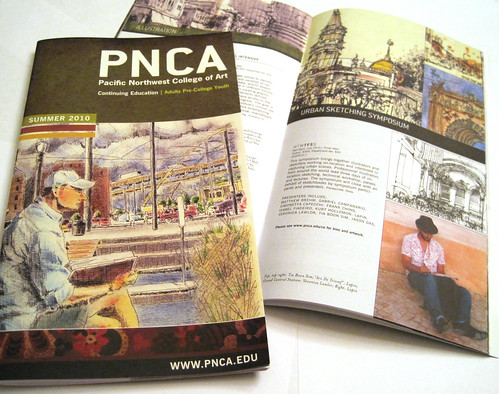
How appropriate that PNCA's catalogue of summer courses features an urban sketcher in action on the cover! The artwork is by Kurt Hollomon, who teaches Illustration and Drawing in the BFA program and will be a Symposium instructor. If you are not familiar with Kurt's work yet, check his blog Shapes and Spaces and his website. Every pencil stroke is a lesson! (The sketcher with a hat on the Symposium page is globetrotting sketcher Lapin. The French illustrator is currently in Japan filling out this cool sketchbook.)
Labels:
Kurt Hollomon,
Lapin,
PNCA
Monday, April 12, 2010
Interview with presenter Frank Ching
During our monthly sketchcrawls in Seattle, Frank Ching is just another drawing enthusiast, passing his sketchbook around, giving feedback, asking questions and sharing the jovial atmosphere. But when you see his work, you realize Frank is no accidental sketcher. Over 35 years, he has taught generations of architects how to draw and has written numerous best-selling books about architectural drawing and design that have been translated to over 16 languages.
I've met many academics of different fields before, but never someone as approachable and generous as Professor Ching. He recently retired from full-time teaching at the University of Washington, so I'm especially grateful that he will share his talent and teachings with us in Portland.
How did your career teaching architectural drawing start? What attracted you to it?
Toward the end of my year's service in VISTA in 1972, I got a call from a former classmate who was teaching at Ohio University, asking me if I were interested in interviewing for a teaching job. Not having any plans or commitments, I agreed to drive down from Cleveland to Athens, Ohio, for the interview. I remember the chair of the department of architecture asking me if I thought I could teach drawing and being young and naive, I of course said yes. So it was a fortuitous set of circumstances that led me to become an "accidental" academic.
How do you get your students to improve their skills? What's your teaching methodology?
I have come to believe that iteration — constant and repetitive practice — is important to learning visual and drawing skills. We can learn more from doing many smaller sketches rather than one or two larger drawings. I also think that drawing from observation, on location, and developing visual acuity should provide the basis for drawing from the imagination in design. But above all, design students should understand that drawing is a language with which we communicate our ideas and observations.
What tools do you use to sketch?
My palette is very simple: a fountain pen and a sketchbook. While I admire others who handle other media so well — pencils, watercolors, pastels — I have come to really love the tactile feel of an ink nib on paper and the fluidity and incisiveness of the strokes. And the abstract quality of an ink-line drawing is actually very liberating for me.
What do you recommend to people attending the Symposium as preparation?
I don't have any specific recommendations. Drawing occurs in the moment. All that will be required is to be present, be observant, and respond to the qualities of a place.
Have you been to Portland? What are you looking for in the Symposium experience?
Despite living in Seattle for almost 30 years, I have only been to Portland a handful of times. I fondly recall, however, the pedestrian-friendly scale of the downtown area and I'm looking forward to meeting and working with others who love drawing. Now that I am retired from active teaching, these kinds of workshops are my favorite ways to teach as well as learn.
Some of Professor Ching's books:
I've met many academics of different fields before, but never someone as approachable and generous as Professor Ching. He recently retired from full-time teaching at the University of Washington, so I'm especially grateful that he will share his talent and teachings with us in Portland.
A sketchcrawl participant browses through Ching's sketchbook.
Ching drawing at Gas Works Park in Seattle.
A sketch of Seattle's Fishermen's Terminal.
Toward the end of my year's service in VISTA in 1972, I got a call from a former classmate who was teaching at Ohio University, asking me if I were interested in interviewing for a teaching job. Not having any plans or commitments, I agreed to drive down from Cleveland to Athens, Ohio, for the interview. I remember the chair of the department of architecture asking me if I thought I could teach drawing and being young and naive, I of course said yes. So it was a fortuitous set of circumstances that led me to become an "accidental" academic.
How do you get your students to improve their skills? What's your teaching methodology?
I have come to believe that iteration — constant and repetitive practice — is important to learning visual and drawing skills. We can learn more from doing many smaller sketches rather than one or two larger drawings. I also think that drawing from observation, on location, and developing visual acuity should provide the basis for drawing from the imagination in design. But above all, design students should understand that drawing is a language with which we communicate our ideas and observations.
What tools do you use to sketch?
My palette is very simple: a fountain pen and a sketchbook. While I admire others who handle other media so well — pencils, watercolors, pastels — I have come to really love the tactile feel of an ink nib on paper and the fluidity and incisiveness of the strokes. And the abstract quality of an ink-line drawing is actually very liberating for me.
What do you recommend to people attending the Symposium as preparation?
I don't have any specific recommendations. Drawing occurs in the moment. All that will be required is to be present, be observant, and respond to the qualities of a place.
Have you been to Portland? What are you looking for in the Symposium experience?
Despite living in Seattle for almost 30 years, I have only been to Portland a handful of times. I fondly recall, however, the pedestrian-friendly scale of the downtown area and I'm looking forward to meeting and working with others who love drawing. Now that I am retired from active teaching, these kinds of workshops are my favorite ways to teach as well as learn.
Some of Professor Ching's books:
Labels:
Frank Ching
Sunday, April 11, 2010
Who else is coming?
 Are you on Facebook? The Symposium has been made an event on the Urban Sketchers fan page. You can RSVP to the event and start seeing everyone who will be joining us in July, when we can finally start putting a face with a name/sketch/avatar.
Are you on Facebook? The Symposium has been made an event on the Urban Sketchers fan page. You can RSVP to the event and start seeing everyone who will be joining us in July, when we can finally start putting a face with a name/sketch/avatar.
Saturday, April 10, 2010
Portland through the eyes of local urban sketchers
To get in the mindset of drawing Portland this summer, we are asking local artists to share their experience. We begin this series of posts with Bill Sharp, a painter and urban sketcher with an affinity for industrial landscapes. Bill got his BFA in painting and printmaking from the University of Delaware and moved to Portland in 1981.


You can see more of Bill's art on flickr and on his blog Pocket Sketchbook Meditations.

"Having grown up in the suburban sprawl of the east coast, I love living and drawing in a small metropolis. Portland has the feel of a city but is small enough to be able to get to know it intimately. With great public transportation, bike friendliness and the individual characteristics of the different neighborhoods, it's custom made for sketchcrawling.
I'm particularly interested in industrial scenes, that don't necessarily appeal to everyone, and I like to set off spontaneously, so often end up on solo sketching sessions. Some of my favorite places to go include the NW industrial zones near or along the rivers.
Sitting on the loading dock of an abandoned warehouse with my sketchbook is my idea of a relaxing Sunday morning."

You can see more of Bill's art on flickr and on his blog Pocket Sketchbook Meditations.
Labels:
Portland sketchers
Thursday, April 8, 2010
Symposium's Frequently Asked Questons
We know you have lots of questions about the Symposium, so we are starting an FAQ section to address anything you'd want to know. Where are Portland's famous microbrews? Should I bring my swimsuit? Sun lotion? There's no such thing as a bad question! Leave a comment on the FAQ page and we'll get right to it.
Wednesday, April 7, 2010
Sharing and learning starts with Paul Heaston's sketches of Portland
Let's get this blog started, shall we? We don't want to wait until we meet in Portland to start sharing and learning together. As the rest of presenters and I begin posting on this blog, we encourage Symposium participants and people considering to attend to join the conversation. This is your blog! We want to make it as useful as possible and get to know everyone a little bit before the Symposium starts in July.
Like other presenters, I'll be sharing some of my work and highlights about my sessions here in the following weeks, but today I want to do my first post about an artist I am a big fan of. I'm talking about Paul Heaston, an incredibly gifted painter and drawer who contributes to the Urban Sketchers blog from San Antonio, and previously from Bozeman. I'm always captivated by his masterful crosshatching technique and solid compositions, and also by the fact that he doesn't even need to add color to achieve great richness in contrast and depth.
Like other presenters, I'll be sharing some of my work and highlights about my sessions here in the following weeks, but today I want to do my first post about an artist I am a big fan of. I'm talking about Paul Heaston, an incredibly gifted painter and drawer who contributes to the Urban Sketchers blog from San Antonio, and previously from Bozeman. I'm always captivated by his masterful crosshatching technique and solid compositions, and also by the fact that he doesn't even need to add color to achieve great richness in contrast and depth.
I first became familiar with his detailed and energetic linework when I discovered his sketches of Main Street Bozeman and interviewed him for the Urban Sketchers blog. His flickr nickname is not "paul is just dandy" anymore — I loved that nickname by the way, but his sketches continue to be dandy, each of them a lesson worth studying line by line.
Since Paul has sketched in Portland and knows the area, I asked him what it was like to sketch there. I leave you with his impressions, in pictures and words (thanks for sharing Paul!)
You can see a slideshow of Paul's complete Portland sketchbook here. And more of his work on his blog three letter word for art, flickr and website.
Since Paul has sketched in Portland and knows the area, I asked him what it was like to sketch there. I leave you with his impressions, in pictures and words (thanks for sharing Paul!)
Sketching from E. Side Esplanade
3rd and Yamhill
Hawthorne and SE 37th Ave.
Hawthorne and 14th Ave.
Pioneer Square
"Last year I visited Portland for a few days and had the opportunity to sketch while I was there. Portland has a wonderful funky urban vibe and density, and each neighborhood is unique and full of character. I was surprised by how compact and easy-to-get-around Portland is. A lot of folks just ride their bicycles or walk. There are some amazing public spaces as well — practically every street or landscape provides you with an opportunity to sketch, to the point where it became difficult to choose. Along the Willamette River there are beautiful bridges, park spaces and promenades. Downtown has a fantastic mix of prewar and contemporary architecture, and the Pearl District is a great reclaimed industrial area that's now full of shops and galleries. In the few days I was there, I filled half my sketchbook."
You can see a slideshow of Paul's complete Portland sketchbook here. And more of his work on his blog three letter word for art, flickr and website.
Labels:
crosshatching,
moleskine,
Paul Heaston,
Portland
Tuesday, April 6, 2010
See Portland, one drawing at a time
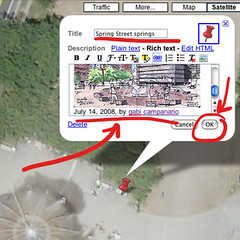 Our interactive map of sketch-worthy locations in Portland now includes a link to step-by-step instructions on how to pin your drawings to it. We only have a few pinned down so far but hope many more sketchers will join the collaboration. We'll surely be adding many more as we roam the city with our sketchbooks this summer.
Our interactive map of sketch-worthy locations in Portland now includes a link to step-by-step instructions on how to pin your drawings to it. We only have a few pinned down so far but hope many more sketchers will join the collaboration. We'll surely be adding many more as we roam the city with our sketchbooks this summer. Some of the Symposium presenters also have Google maps. See Tia's sketches in Singapore and Lapin's in Barcelona.
Monday, April 5, 2010
Welcome to the Symposium's blog

The countdown to the Symposium has started. It's exactly 116 days away, not even four months!
Are you ready? Have you booked your flight? Do you know what sketching gear you're going to pack? What places do you want to visit around the scenic Pacific Northwest of the United States?
This blog will be the central hub of information to help you prepare for the trip and get the most out of the Symposium, our first educational initiative as a nonprofit. Here you will find schedule details, interviews with the presenters, and insights about drawing and life in Portland, also known as the City of Roses.
As a starter, check the interactive map and see where local urban sketchers have already uncapped their pens and used up their watercolors. You can also follow links on the sidebar to learn about local attractions or public transportation.
We hope that, by the time the Symposium starts, participants will already know each other a little bit from the exchanges had on this blog. We will also be blogging the Symposium here for those who won't be able to come to Portland.
If you have any questions, leave a comment here or contact us directly. To register, check PNCA's website.
Looking forward to meeting you in Portland!
P.S.: Symposium poster available for download here in different sizes, including hi-res 11'x17" for printing purposes.
Subscribe to:
Comments (Atom)

